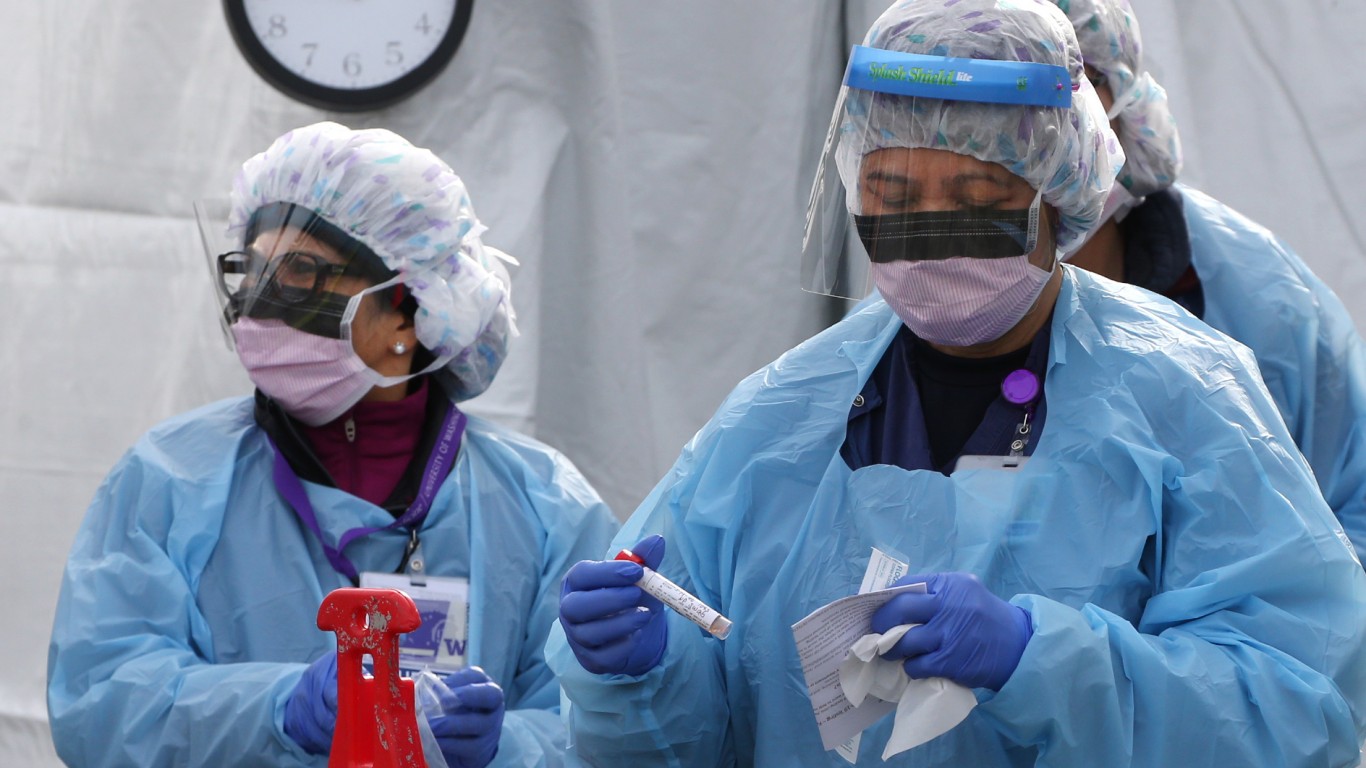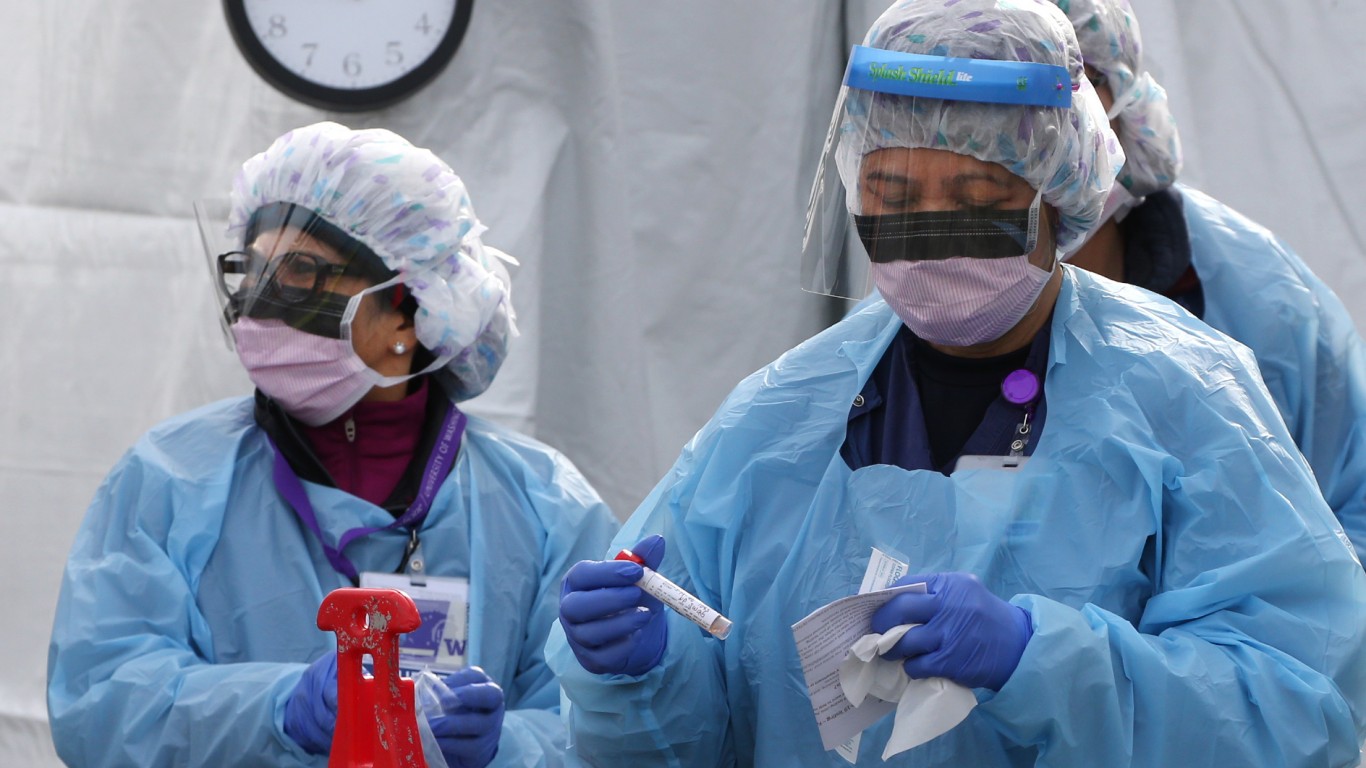
According to a recent study by researchers at Princeton University published in the Proceedings of the National Academy of Sciences in August 2021, extreme pandemics like COVID-19 will become more common and more intense in the near future. The researchers estimate the chance of someone born today will be experiencing a pandemic similar to COVID-19 in their lifetime at 38% – a figure that may double in coming decades.
Among the factors that are increasing the likelihood of pandemics are increased global travel, urbanization, climate change, increased human-animal contact, and health worker shortages. (Here are the states with the fewest and most doctors per person.)
The Centers for Disease Control and Prevention tracks the development of diseases and outbreaks both in the U.S. and abroad. An outbreak is defined as an instance when there are more cases of a disease than expected in a specific location over a specific time period. To determine current outbreaks in the United States, 24/7 Tempo reviewed the CDC’s Current Outbreak List. Currently, the CDC lists 11 major ongoing investigations into U.S.-based outbreaks. The outbreaks are ordered by date reported.
Many of the most recent outbreaks involve foodborne illnesses spread across multiple states. Examples include norovirus from raw oysters harvested in Galveston Bay in Texas, Listeria infections from enoki mushrooms imported from Korea, and Brucella infections from raw milk products sold in the United States.
Other alarming outbreaks concern everyday consumer products. While the health risks of vaping are well known and lung injury due to e-cigarette use was declared an outbreak in August 2019, a more recent outbreak involves popular eye drop brands.
According to the CDC, infections caused by a rare drug-resistant strain of the bacterium Pseudomonas aeruginosa present in bottles of artificial tears has caused widespread eye pain, blurry vision, and, in some cases, more severe symptoms, including death. As of March 2023, 68 infections have been reported in the United States, including eight reports of vision loss, four reports of surgical eye removal, and three deaths. (Also see, the most common cancers in America and their survival rates.)
Click here for a list of the currently ongoing outbreaks in the U.S.

11. Outbreaks of hepatitis A in multiple states among people who are homeless and people who use drugs
> Outbreak announced: March 2017
Hepatitis A is a highly contagious viral infection that causes liver inflammation and can lead to symptoms such as fever, fatigue, nausea, vomiting, and jaundice. While hepatitis A can be contracted through the ingestion of contaminated food and water, the virus is most commonly spread person to person, putting people who use drugs, are incarcerated, or are homeless at the highest risk. The CDC declared an official hepatitis A outbreak March 2017, after several states reported local outbreaks among high-risk populations.
Since 2016, nearly 45,000 cases, including over 27,000 hospitalizations and 421 deaths, have been associated with the outbreaks. While a majority of states have declared an end to this outbreak, outbreaks are currently ongoing in Georgia, Indiana, Maine, Maryland, Mississippi, Missouri, and Pennsylvania. The CDC notes that the hepatitis A vaccine is the best way to prevent HAV infection.
[in-text-ad]

10. Widespread measles outbreaks
> Outbreak announced: January 2019
While the CDC officially declared measles eliminated in the United States in 2000, nearly 1,300 cases of the virus were reported in 31 U.S. states in 2019. The CDC explains that measles can enter the U.S. with travelers entering the country, or Americans returning to the country after contracting the virus abroad. For example, the largest source countries for the outbreak from Jan. 1-Oct. 1, 2019, included the Philippines, Ukraine, and Israel.
According to the CDC, 91% of children in the United States are vaccinated against measles, mumps, and rubella by age two. Most of those who were infected were unvaccinated (70%), and the vaccination status of another 19% was unknown.

9. Drug-resistant Brucella bacteria in raw milk
> Outbreak announced: February 2019
The consumption of raw, unpasteurized milk containing Brucella bacteria can result in brucellosis, an illness causing fever, sweats, headaches, back pains, and weakness. While Brucella infections are typically responsive to antibiotics, there have been in recent years a significant number of brucellosis cases in the U.S. that were resistant to certain antibiotics. And while most cases of antibiotic-resistant Brucella infections originated outside of the U.S., some may have originated from raw milk products sold in mainstream supermarkets in the U.S.

8. Lung Injury associated with e-cigarette use and vaping
> Outbreak announced: August 2019
From 2019 to 2020, more than 2,800 hospitalizations and deaths from e-cigarette use and vaping product use-associated lung injury (EVALI) were reported in the United States. Many of these cases have been linked to unregulated or counterfeit THC vaping products, which often contain high amounts of harmful vitamin E acetate additives.
The CDC officially declared the increase in EVALI cases an outbreak in August 2019. The outbreak disproportionately affects younger Americans, with 52% of hospitalizations and deaths occurring amongst those under 25 years old.
[in-text-ad-2]

7. COVID-19
> Outbreak announced: January 2020
On Jan. 20, 2020, the CDC reported the first laboratory-confirmed case of COVID-19 in the U.S. A second case was confirmed several days later, and by the end of the month, the CDC issued a 14-day quarantine for all those returning to the country from Wuhan, China. COVID-19 cases and deaths rose precipitously from there, with deaths peaking in the winter of 2021 and surpassing the 1918 flu as the deadliest pandemic in American history.
While the fallout from COVID-19 is far from over and the scope of impact far from realized, there have been 1.1 million deaths due to COVID-19 in the U.S. to date.

6. Hepatitis of unknown cause in children
> Outbreak announced: May 2022
In October 2021, five pediatric patients at a hospital in Alabama were found to have inflammation of the liver – or hepatitis – with no known cause. The children tested negative for hepatitis A, hepatitis B, and hepatitis C, and had no known contact or common exposures. After similar cases of hepatitis in children were reported in 45 other states, the CDC officially declared the spike in pediatric hepatitis an outbreak in May 2022.
While the United States and United Kingdom account for a majority of the mystery pediatric hepatitis cases worldwide, more than 1,300 children in 37 countries have developed acute severe hepatitis of unknown etiology as of April 2022.
[in-text-ad]

5. Listeria outbreak linked to deli meat and cheese
> Outbreak announced: November 2022
Listeria is a foodborne germ that causes listeriosis, an infection that can result in fever and diarrhea, but more severely affect pregnant women, newborns, older adults, and people with weakened immune systems. Since April 2021, 13 hospitalizations and one death were tied to Listeria illnesses from deli meats and cheeses.
Listeria can survive and grow in cold temperatures, and easily spreads among food on deli countertops, slicers, and surfaces. While it is difficult to identify the primary source of the illness, the majority of cases have been reported in New York and Maryland.

4. Listeria outbreak linked to enoki mushrooms
> Outbreak announced: November 2022
In 2020, the CDC investigated the first known Listeria outbreak in the United States linked to enoki mushrooms. The outbreak resulted in recalls of several mushroom brands, including Utopia Foods and Sun Hong Foods.
Symptoms of listeriosis include fever, muscle aches, and tiredness, though they also get a headache, stiff neck, confusion, loss of balance, or seizures. In pregnant people, Listeria can cause pregnancy loss or premature birth and serious illness or death in newborns. Recent hospitalizations due to enoki mushrooms have been reported in California, Nevada, and Michigan.
3. Norovirus outbreak linked to raw oysters
> Outbreak announced: December 2022
In December 2022, the Texas Department of State Health ordered a recall of all oysters harvested in southeastern Galveston Bay after several dozen reports of gastrointestinal illness among people who consumed oysters from the area.
The Food and Drug Administration has since confirmed that these raw oysters were likely contaminated with norovirus, and has linked the contaminated oysters with norovirus cases in Alabama, Florida, Georgia, Louisiana, Mississippi, North Carolina, Tennessee, and Texas. Symptoms of norovirus include diarrhea, vomiting, nausea, and stomach pain. As of December, approximately 300 cases of norovirus related to the oysters have been reported.
[in-text-ad-2]

2. Outbreak of drug-resistant Pseudomonas aeruginosa associated with artificial tears
> Outbreak announced: February 2023
The CDC is currently investigating a multistate outbreak of eye infections due to a drug-resistant strain of Pseudomonas aeruginosa present in bottles of artificial tears. While the investigation has tied the outbreak to over 10 different brands of eye drops, the most commonly reported brand is EzriCare Artificial Tears.
The most common eye infection symptoms associated with the outbreak include discharge from the eye, eye pain, increased sensitivity to light, blurry vision, and, in some cases, vision loss. As of March 2023, 68 infections have been reported in the United States, including eight reports of vision loss, four reports of surgical eye removal, and three deaths.

1. Listeria outbreak from unknown food source
> Outbreak announced: February 2023
The CDC recently announced an outbreak of Listeria tied to an unknown food source. The outbreak began in 2018 and has since been tied to 11 hospitalizations in 10 states. Affected states include Michigan, New York, Pennsylvania, North Carolina, Arkansas, Missouri, South Dakota, Colorado, California, and Washington. The median age of the affected patients is 73. While no deaths have been reported, the CDC has stated that the true number of sick people affected by the outbreak is likely higher than the one reported.
In 20 Years, I Haven’t Seen A Cash Back Card This Good
After two decades of reviewing financial products I haven’t seen anything like this. Credit card companies are at war, handing out free rewards and benefits to win the best customers.
A good cash back card can be worth thousands of dollars a year in free money, not to mention other perks like travel, insurance, and access to fancy lounges.
Our top pick today pays up to 5% cash back, a $200 bonus on top, and $0 annual fee. Click here to apply before they stop offering rewards this generous.
Flywheel Publishing has partnered with CardRatings for our coverage of credit card products. Flywheel Publishing and CardRatings may receive a commission from card issuers.
Thank you for reading! Have some feedback for us?
Contact the 24/7 Wall St. editorial team.
 24/7 Wall St.
24/7 Wall St.![raw oyster / belgo oyster fair by [puamelia] raw oyster / belgo oyster fair by [puamelia]](https://a673b.bigscoots-temp.com/wp-content/uploads/2022/10/imageForEntry9-hqM.jpg)



